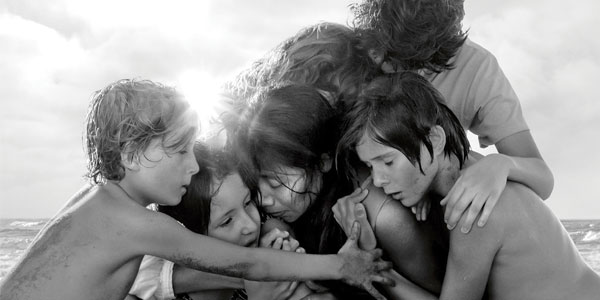
By Jorge Ramos
After watching ‘Roma,’ Alfonso Cuarón’s new film, recently, I left the theater a bit disoriented, as often happens when a movie so overwhelms you. With all my soul I wanted to go back into the theater and be carried away again.
I must offer Cuarón my gratitude for having recaptured my childhood in Mexico City, which I thought was lost forever. Yet there it was on the screen: the Choco Milk I used to drink; Gansitos snack cakes in the fridge; the Scalextric raceway I played with; my father’s white Valiant, and the black Galaxy my friend Benjamin’s mother used to drive. There were vinyl records, and the competitions held on La Pantera radio between the Beatles and the latest up-and-coming band. There was El Loco Valdez’s comic show, the joy of hailstorms; the city where I grew up.
The movie is full of exquisite detail. I can imagine what the set designers must have gone through to find all the right TV sets, radios, posters and costumes needed to recreate the scenes from Cuarón’s prodigious memory. I read in an interview that 90 percent of the film is based on Cuarón’s recollections, which is evident.
The result — the black-and-white film was shot by the director himself, on 65 millimeter film for better resolution — is comparable to dreams I’ve had in which I roam my childhood home. In these dreams, I move without haste. There’s time, for example, to watch the water drain after the patio has been washed down, as is depicted in the film. (Cuarón’s frequent collaborator, Emmanuel “Chivo” Lubezki, was slated to be the director of photography for ‘Roma,’ but had to leave the project just before it began filming.)
The movie is set between 1970 and 1971. During the first year Mexico hosts the World Cup, and in the second we experience the Corpus Christi massacre, in which more than 100 student demonstrators were killed by the “Halcones,” a group of elite soldiers trained under President Luis Echeverría Alvarez’s administration.
During these years, when I was 12 and 13 years old, my world revolved around soccer. But the film accurately depicts the world outside as well, particularly the Institutional Revolutionary Party’s authoritarian tactics and bloody repression. It almost serves to remind us why, decades later, so many Mexicans voted for a change, and against that party.
What is most surprising and revolutionary about the film, however, is that in depicting a Mexican society that can be quite classist, racist and misogynistic, the main character is an indigenous woman, Cleo. She is a maid, one of two women who work for a middle class family in Mexico City’s Roma neighborhood. Cleo provides the emotional and fundamental bonds that hold the family together as she looks after the children and keeps the house running smoothly.
The film celebrates women. A real-time scene in which Cleo gives birth is so lifelike your hands might begin to sweat. The children’s mother, who after a night out finally acknowledges that her husband is not coming back, tells Cleo a slashing truth: Remember that we women will always be alone.
I’m sure Cuarón is present in all the characters of this film. And despite being a mere audience member, I was there, too: in the eldest son trying to rule over his siblings; in the teenager who almost drowns in the ocean because he wants to prove he is a man. Images from the film mixed with my own memories. When ‘Roma’ is available on Netflix in mid-December, I will watch it again, alone in my home. I’m afraid that I will laugh and cry throughout.
I tried for many years to recover my childhood in Mexico, collecting as many details as possible. Those of us who leave tend to lose the details. And while I have written about childhood many times, I have never been able to convey my own memories in vivid images and recalled moments. When I watched ‘Roma,’ I thought to myself: “This is it.”
Who says you can’t recapture the past?
___________________________________________________________________________________________________
‘Roma’: La Infancia Recuperada
Terminé de ver la película “Roma” y no me quería ir. De hecho, salí del cine y no reconocí el lugar. Es esa desorientación que ocurre cuando un film se impone de manera abrumadora sobre tu realidad. Paré y tuve que reconocer que deseaba con toda mi alma regresar al teatro y meterme, de nuevo, en la película.
Tengo que agradecerle al director Alfonso Cuarón que haya recuperado una infancia que yo creía perdida para siempre. Ahí estaban en la pantalla el Choco Milk que yo tomaba de niño; los Gansitos congelados en el refrigerador; la Scalextric con que jugaba; el auto Valiant blanco que tenía mi papá y el Galaxy negro que manejaba la mamá de mi amigo Benjamín; los discos de acetato y las competencias en la estación de radio La Pantera entre los Beatles y el grupo del momento; el programa cómico del Loco Valdez; la alegría de las granizadas. La ciudad donde crecí.
La película está llena de hermosos detalles. Me imagino la pesadilla de la gente de utilería y del set para encontrar el televisor exacto — y la radio, los libreros, los posters, la ropa, los autos, la cartelera — que exigía la prodigiosa memoria del director. Leí en una entrevista que el 90% de la película fue una investigación interior de Cuarón…y se lo creo.
La película, en blanco y negro y filmada por el propio Cuarón en 65 milímetros para mayor resolución, es lo más cercano a esos sueños que tengo donde recorro la casa de mi infancia. Son sueños sin prisa, donde hay tiempo para ver cómo se va el agua por la alcantarilla luego de que lavan el patio de la casa, igual que en la primera escena de la película. (Emmanuel “Chivo” Lubezki iba a ser el director de fotografía, pero tuvo que dejar el proyecto justo antes de empezar a rodar.)
Cuarón encuadra la película en 1970 y 1971. El primer año es cuando se juega el Mundial de fútbol en México y el segundo, ya con un nuevo presidente, cuando se realiza la llamada masacre del jueves de Corpus. Más de 100 jóvenes fueron asesinados por los “Halcones”, un grupo paramilitar entrenado por el gobierno del presidente Luis Echeverría Alvarez.
A mis 12 y 13 años yo estaba más preocupado por el fútbol que por cualquier otra cosa. Pero la película refleja el autoritarismo y la sanguinaria represión del Partido Revolucionario Institucional. (Sólo para que no se nos olvide por qué tantos mexicanos votaron por el cambio, y en contra del PRI, décadas después.)
Quizás lo más sorprendente y rebelde de la película es que, aún en la clasista, racista y machista sociedad mexicana, la protagonista es una mujer indígena: Cleo. Ella es la empleada de servicio que, junto a una compañera, trabaja para una familia de clase media en la colonia Roma de la capital mexicana. Pero Cleo es la conexión, emocional y esencial, que une a la familia, cuida a los niños y permite que la casa funcione. La escena, en tiempo real, del parto de Cleo es tan realista que no hay manera de evitar que te suden las manos.
Esta es una película que celebra a las mujeres. La madre de los niños — luego de una noche de copas y de reconocer que su esposo ya no iba a regresar — le dice a Cleo, en su momento más feminista, una verdad fulminante: Recuerda que las mujeres siempre vamos a estar solas. (Esa es una sentencia brutal para los hombres.)
Estoy seguro que Cuarón está bien repartido entre los personajes de la película. Pero mi gran descubrimiento fue personal. A pesar de ser un simple espectador, yo también estaba ahí: Era el primogénito que trataba de imponerse a sus hermanos o el adolescente que estaba a punto de ahogarse en la playa porque quería demostrar su recién despertada hombría. Tuve una extrañísima experiencia en que las imágenes de la cinta se mezclaron con mis propias memorias. Cuando la película se transmita por Netflix, a mediados de diciembre, y la pueda ver solo en mi casa otra vez, temo torrentes de lágrimas y risas.
Durante años había tratado de rescatar, con minuciosos detalles, mi infancia en México. (Eso nos pasa a los que nos vamos.) Muchas veces había escrito al respecto. Pero nunca había podido visualizar esos recuerdos. Y de pronto vi “Roma” y supe que yo era de ahí.
¿Quién dice que no se puede recuperar el tiempo perdido?









